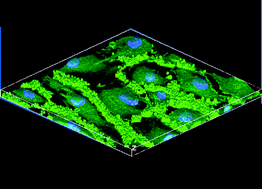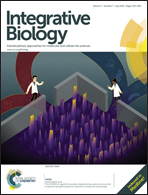A vascular injury model using focal heat-induced activation of endothelial cells†
Abstract
Endothelial cells (EC) both inhibit and promote platelet function depending on their activation state. Quiescent EC inhibit platelet activation by constitutive secretion of platelet inhibitors. Activated EC promote platelet adhesion by secretion of von Willebrand factor (vWF). EC also secrete an extracellular matrix that support platelet adhesion when exposed following vascular injury. Previous studies of EC–platelet interactions under flow activate entire monolayers of cells by chemical activation. In this study, EC cultured in microfluidic channels were focally activated by heat from an underlying microelectrode. Based on finite element modeling, microelectrodes induced peak temperature increases of 10–40 °C above 37 °C after applying 5–9 V for 30 s resulting in three zones: (1) a quiescent zone corresponded to peak temperatures of less than 15 °C characterized by no EC activation or platelet accumulation. (2) An activation zone corresponding to an increase of 16–22 °C yielded EC that were viable, secreted elevated levels of vWF, and were P-selectin positive. Platelets accumulated in the retracted spaces between EC in the activation zone at a wall shear rate of 150 and 1500 s−1. Experiments with blocking antibodies show that platelets adhere via GPIbα–vWF and α6β1–laminin interactions. (3) A kill zone corresponded to peak temperatures of greater than 23 °C where EC were not viable and did not support platelet adhesion. These data define heating conditions for the activation of EC, causing the secretion of vWF and the exposure of a subendothelial matrix that support platelet adhesion and aggregation. This model provides for spatially defined zones of EC activation that could be a useful tool for measuring the relative roles of anti- and prothrombotic roles of EC at the site of vascular injury.


 Please wait while we load your content...
Please wait while we load your content...